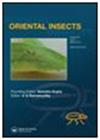印度蓖麻(Ricinus communis Linnaeus)为食,1986年首次报道(鳞翅目:蓖麻科)
IF 0.6
4区 农林科学
Q4 ENTOMOLOGY
引用次数: 1
摘要
本文报道了一种以开花油籽植物蓖麻(Ricinus communis L.)为食的新害虫——北蛾Olepa koslandana Orhant, 1986,这也是首次报道了这种昆虫与植物的关联。此外,还提供了印度以蓖麻为食的害虫种类清单。本文章由计算机程序翻译,如有差异,请以英文原文为准。
First report of Olepa koslandana Orhant, 1986 (Lepidoptera: Erebidae) feeding on economically important oilseed plant castor (Ricinus communis Linnaeus) from India
ABSTRACT In the present paper, Olepa koslandana Orhant, 1986, an Arctiid moth, is reported as a new pest feeding on flowering oilseed plant castor (Ricinus communis L.) from the Indian region, which also reports the first association of this insect with any plant species. In addition, a list of pest species of moths that feeds on castor in India are also provided.
求助全文
通过发布文献求助,成功后即可免费获取论文全文。
去求助
来源期刊

Oriental Insects
生物-昆虫学
CiteScore
1.60
自引率
0.00%
发文量
34
审稿时长
>12 weeks
期刊介绍:
Oriental Insects is an international, peer-reviewed journal devoted to the publication of original research articles and reviews on the taxonomy, ecology, biodiversity and evolution of insects and other land arthropods of the Old World and Australia. Manuscripts referring to Africa, Australia and Oceania are highly welcomed. Research papers covering the study of behaviour, conservation, forensic and medical entomology, urban entomology and pest control are encouraged, provided that the research has relevance to Old World or Australian entomofauna. Precedence will be given to more general manuscripts (e.g. revisions of higher taxa, papers with combined methodologies or referring to larger geographic units). Descriptive manuscripts should refer to more than a single species and contain more general results or discussion (e.g. determination keys, biological or ecological data etc.). Laboratory works without zoogeographic or taxonomic reference to the scope of the journal will not be accepted.
 求助内容:
求助内容: 应助结果提醒方式:
应助结果提醒方式:


